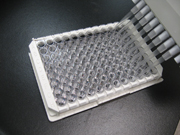Ferric Reducing Antioxidant Power (FRAP) Assay Kit

- Quick, 10 minute protocol
- Measures antioxidant potential in samples through the reduction of ferric iron (Fe3+) to ferrous iron (Fe2+)
- Detection sensitivity limit of approximately 4 µM Fe2+ iron equivalents
- Suitable for use with serum, plasma, lysates, biological fluids, and purified food or drug extracts